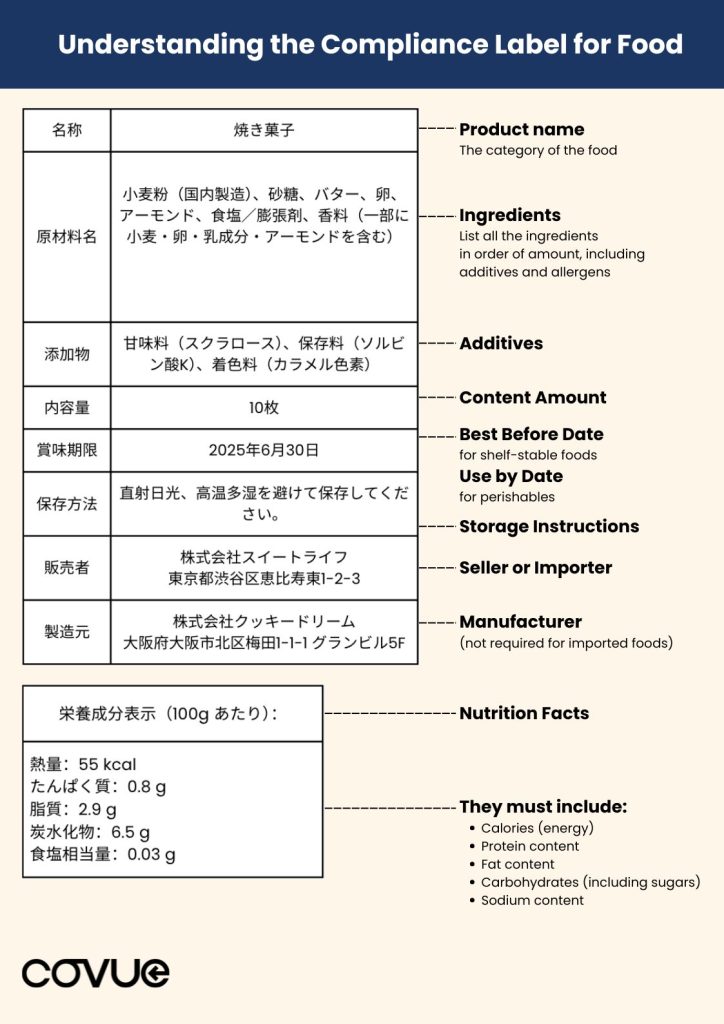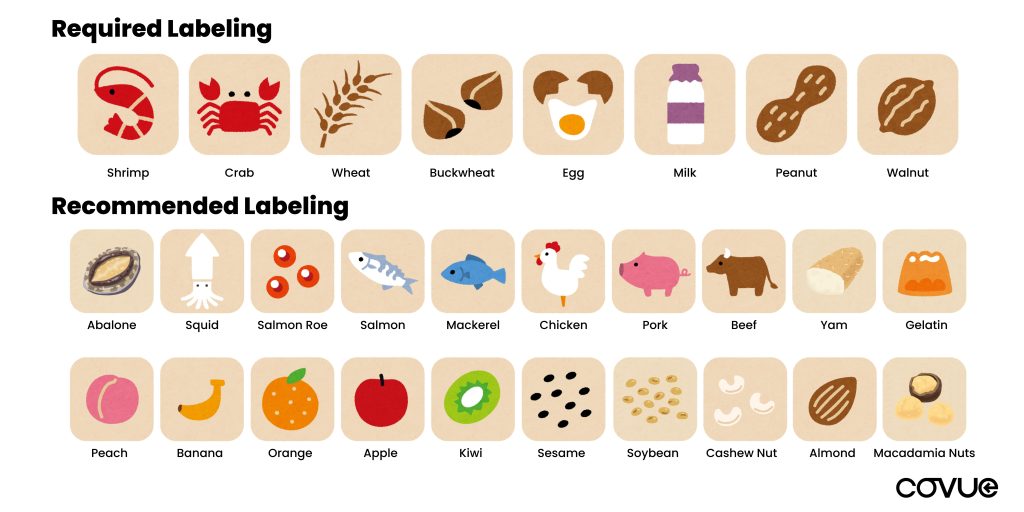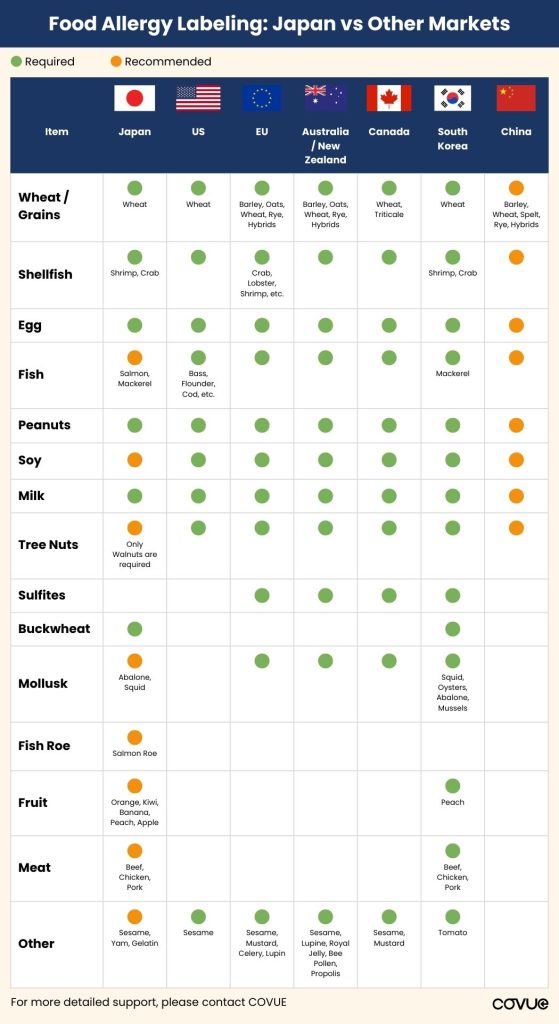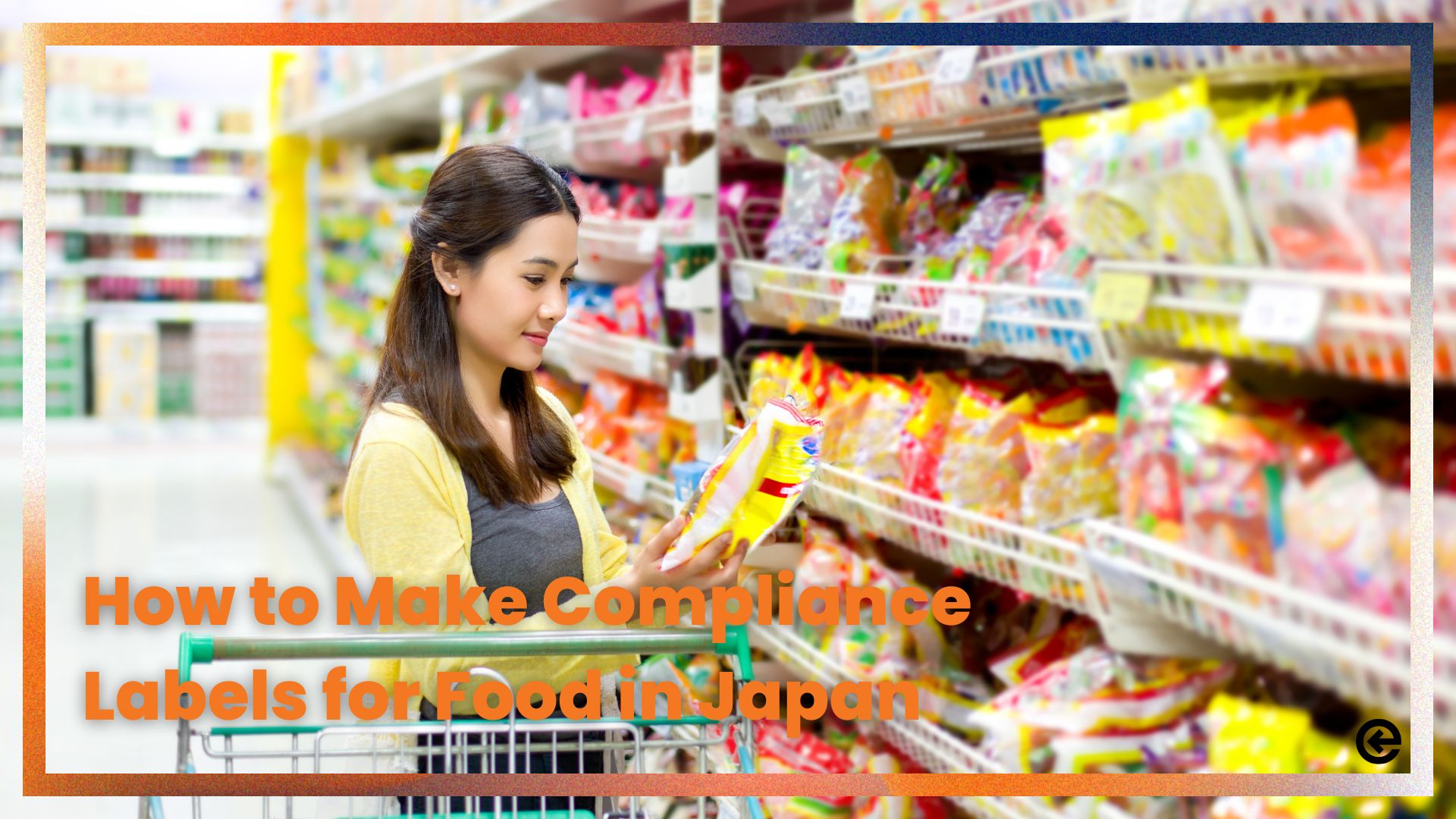How to Make Compliance Labels for Food in Japan: A Complete Guide
Bringing your food products to Japan opens up exciting opportunities. With the right approach, ensuring compliance with food labeling regulations can be a smooth and straightforward process. Whether your products are shelf-stable, perishable, or anywhere in between, the key to a successful market entry lies in accurate and compliant labeling.
Under Japanese law, it’s essential that your food labels meet specific standards to ensure consumer safety and facilitate informed purchasing decisions. Well-labeled products not only meet Japan’s regulatory standards but also build consumer trust and enhance your brand’s credibility. This guide will walk you through the essential elements of food labeling, focusing on the most recent requirements and compliance standards you need to follow for a seamless entry into the Japanese market.
Overview of Japan’s Food Labeling Requirements
Food labels play a vital role in helping consumers make informed choices by clearly presenting key information such as ingredients, allergens, and nutritional content. In cases where food safety concerns arise, accurate labeling also enables fast and effective product tracing—helping authorities and brands respond quickly to minimize risk.
In Japan, food labeling is governed by the Food Labeling Law, which establishes unified, standardized rules for how food information must be displayed. This law outlines mandatory labeling elements—including ingredients, nutritional values, allergens, and country of origin—with the aim of ensuring food safety, accurate traceability, and consumer transparency. All food-related businesses operating in Japan must comply to avoid customs delays, penalties, or product rejections.
The law also promotes better health by encouraging proper nutrition and food management. As of 2025, all transitional deadlines for changes to the requirements—including processed food labeling (March 2020), country of origin disclosure (March 2022), and GMO labeling updates (March 2023)—have passed. Businesses must now ensure full compliance with these standards to avoid delays in market entry or potential legal issues.
Your Importer of Record (IOR) or Attorney for Customs Procedures (ACP) is responsible for submitting your product’s compliance label as part of the import notification process. However, the brand owner is ultimately accountable for providing accurate information and ensuring the label is properly applied to the product before sale.
Let’s dive into all the details of how to ensure your food label complies with Japan’s comprehensive food labeling laws.
Food Labeling Requirements in Japan

Mandatory Information on Food Labels
1. Product Name:
- The name of the product must be clear and accurately reflect the product’s actual contents. For example, if the product is a mixture, this should be reflected in the name (e.g., “Blended Vegetable Soup” or “Herbal Tea Blend”).
2. Ingredients List:
- Ingredients must be listed in descending order by weight. This includes any additives, preservatives, and flavorings used in the product. Any non-compliant or unapproved additives could result in the rejection of the product by Japanese authorities.
- Important: Japan Customs and health authorities often conduct spot testing to verify product contents. If testing reveals ingredients that are restricted, banned, or not properly disclosed—or if they don’t match the information submitted in the import notification—the product may be flagged, delayed, or denied entry altogether. Accurate, transparent ingredient disclosure is critical to avoid compliance issues.
3. Nutritional Information:
- Japan requires detailed nutritional information, which includes the following:
(per 100g serving size)- Calories (energy)
- Protein content
- Fat content
- Carbohydrates (including sugars)
- Sodium content
- This information must be accurate and reflect the product’s nutritional value.
- The nutritional information must be displayed in Japanese on the container packaging. Even if the imported product has nutritional information in a foreign language, it is required to be displayed in Japanese following the method specified by the Food Labeling Standards.
- In nutritional labels in other markets, sodium is typically listed as “sodium content.” However, in Japan, nutritional labels must convert the sodium amount into “salt equivalent” and display it as such.
4. Allergen Information:

- Mandatory Allergens:
The following allergens must be clearly labeled:- Shrimp (えび)
- Crab (かに)
- Walnut (くるみ)
- Wheat (小麦)
- Buckwheat (soba) (そば)
- Egg (卵)
- Milk (乳)
- Peanut (落花生)
- Other Allergens:
There are 20 other common allergens like almonds, soy, sesame, and more. If any of these allergens are present in the product, it’s recommended that they are explicitly stated, but it’s currently not mandatory. - When an allergen is present in the ingredients, it can be listed immediately after the ingredient name in parentheses, such as “Ingredient Name (contains XXX allergen).” For allergens like milk, it should appear as “(contains milk components)
- Alternatively, all allergens can also be listed at the end of the ingredients list in a separate section, like “Contains: XXX, YYY, ZZZ.” If an allergen is present in an additive, the substance name should be followed by parentheses, like “Substance Name (derived from XXX allergen).” For milk, it should read “(derived from milk).”
- In countries like the U.S. and the EU, products can be labeled as “gluten-free” if the gluten concentration is below 20 ppm. However, in Japan, allergen labeling requires the declaration of wheat if the product contains any measurable amount of wheat protein, regardless of whether it meets the gluten-free criteria. Therefore, even if a product is labeled as “gluten-free,” it may still require an allergen label indicating “contains wheat” depending on the wheat protein content, so it’s important to pay attention to this detail.

5. Expiration Date or Best Before Date:
- Best Before Date (賞味期限): For shelf-stable products, including canned goods, the “Best Before” date must be included. This indicates when the product is at its optimal quality.
- Use By Date (消費期限): For highly perishable foods, such as dairy or fresh products, the “Use By” date is required, signifying the last day the product can be safely consumed.
- Format: The date must be written in the format of year-month-day (e.g. 2025.05.12).
6. Storage Instructions:
- Storage instructions must be straightforward and easy to understand, particularly for items requiring special conditions to stay fresh. For example, labels should specify if the product needs refrigeration, should be kept in a cool, dry area, or must be protected from direct sunlight.
7. Country of Origin:
- The country of origin must be clearly stated. This is especially important for imported foods to maintain transparency and allow consumers to make informed decisions.
8. Manufacturing/Importer Details:
- The name and address of the manufacturer or importer must be listed on the packaging. This ensures traceability in case of recalls or quality concerns.
Specific Labeling Requirements for Certain Products
- Supplements:
- Health Claims: If a product makes any health-related claims, such as promoting better digestion or enhancing immunity, it must undergo additional regulatory review and obtain approval before these claims can be included on the label.
- Special Ingredients: Supplements containing substances such as herbal extracts, vitamins, or minerals must clearly indicate the specific quantities per serving.
- Genetically Modified (GMO) Products:
- If the product contains GMO ingredients, these must be clearly labeled. Japan has stringent regulations around GMO products, and failure to label them correctly can result in the product being pulled from the market.
Font and Label Size Regulations
- Contrast in Colors:
- The text and borders on the label must contrast with the background to ensure readability. This ensures that consumers can easily read the label’s important information.
- Font and Size:
- The font itself must be simple and easy to read—decorative or overly stylized fonts should be avoided to ensure clarity and compliance.
- The minimum font size for labels must be 8-point. However, for small labels (under 150cm²), a font size of 5.5-point is allowed.
- Important: The font size applies to the total surface area of the packaging, including the front-facing side with product name, images, and other details. Labels that are smaller than 150cm² must comply with specific font size regulations for legibility.
Special Labeling Cases
- Artificial Sweeteners:
- If a product contains aspartame or similar artificial sweeteners, it must be labeled with a warning: “Contains L-phenylalanine compounds.”
- Labeling Exemptions for Small Containers:
- For containers under 30cm², certain labeling details can be omitted, such as:
- Ingredients
- Additives
- Country of origin
- Nutritional information
- Manufacturer information
- However, safety-related information such as allergens, expiration date, and storage instructions cannot be omitted.
- For containers under 30cm², certain labeling details can be omitted, such as:
- Specified Ingredient-Containing Foods:
- In Japan, food products containing specific ingredients such as Coleus forskohlii, Chelidonium, Pueraria mirifica, and Black Cohosh are required to include labeling indicating that the product contains “specified ingredients” on the packaging.
- For example, Pueraria mirifica-containing products must display a warning that the ingredient requires special attention due to its potential health risks. If you experience any unusual symptoms, you should immediately stop consuming the product and consult with a doctor. It is also advised to contact the provided contact details regarding any adverse reactions.
- Multilingual Labeling
- All required compliance elements (ingredients, allergens, nutritional values, etc.) must be displayed in Japanese, regardless of whether the product includes multilingual labeling. You may include other languages, as long as there are no contradictions between languages and the Japanese version takes precedence. Foreign-language claims or phrases that contradict Japan’s labeling laws must be removed or covered.
Label Placement Options
Food label compliance doesn’t just involve what you say—it’s also how and where you say it. In Japan, brands typically have two options when placing Japanese-compliant labels on their products:
- Option 1: Apply a Sticker Label
Add a black-and-white Japanese sticker label directly onto your original product packaging. This is the most common method for imported products. However, you must ensure that all claims made on the foreign packaging are also compliant in Japan. If the original packaging contains claims not permitted under Japanese law, such as unauthorized health benefits or vague statements (e.g., “boosts immunity”), those areas must be covered or removed. - Option 2: Localize and Print Dedicated Packaging
For brands that want a more seamless look or are focused on retail, it’s possible to localize all packaging content into Japanese and produce fully compliant packaging for the Japanese market. This ensures all elements—including layout, font size, and terminology—are correctly formatted from the start.
Penalties for Non-Compliance
- Failure to comply with Japan’s food labeling regulations can lead to serious consequences for your business. These include:
- Administrative Action: This may involve official warnings, mandated corrections, or temporary suspension of imports.
- Fines and Rejections: Non-compliant products may be denied entry at customs or pulled from retail shelves, potentially resulting in financial loss and reputational damage.
- Market Blacklisting: In cases of repeated or severe violations—such as falsified labeling or undeclared allergens—regulatory authorities may restrict or blacklist the product or brand from future importation into Japan.
Inspections and Enforcement
- While the Food Labeling Act is a domestic law that does not apply directly to foreign companies based outside Japan, it is fully enforceable for any food sold or distributed within the country.
- For imported food products, the responsibility for labeling compliance rests with the Japanese importer or domestic seller. When deemed necessary, the Minister of Agriculture, Forestry and Fisheries (MAFF) may authorize on-site inspections of these parties to verify compliance with labeling regulations.:
- Reviewing records and documents related to ingredients and labeling
- Sampling food for testing purposes
- Asking employees and concerned parties questions to verify label accuracy
- If non-compliance is found, the importer or seller may be required to take corrective measures such as relabeling, product recalls, or suspension of sales, which will have a direct impact on your business within Japan.
How COVUE Can Support Your Labeling Compliance Journey
Pre-Market Check:
At COVUE, we make sure that your product is fully prepared for success in the Japanese market.
As part of our services, we offer pre-market checks to review your product and ensure it meets all necessary regulations before your product reaches the market. Since we manage the food import notification process, we require the label to be submitted as part of this process. COVUE will carefully review the contents, ensuring everything is included. We typically provide a black and white version of the label as part of our service and do not accept labels created by clients without a full review to guarantee compliance.
Label Localization:
We help bring your product to life in Japan by expertly localizing your labels. This ensures your labels meet Japanese standards, from the correct ingredient lists to allergen information and compliance with the Food Labeling Law, all while keeping the integrity of your brand intact.
Japan’s regulatory landscape can be complex, but with COVUE by your side, you don’t have to stress about the details. We ensure your label is compliant and meets every requirement. With our expertise, you can confidently bring your product to market, knowing that all aspects of food labeling and import regulations are fully covered.
Contact us today to get your product into Japan!


